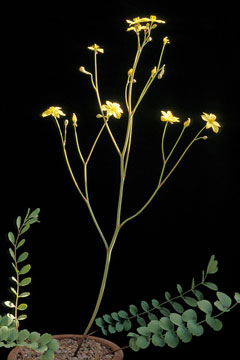 |
|
http://flickr.com/photos/68039521@N00 |
 |
|
Translate this page:
Summary
Physical Characteristics

 Bongardia chrysogonum is a PERENNIAL growing to 0.2 m (0ft 8in) by 0.2 m (0ft 8in) at a slow rate.
Bongardia chrysogonum is a PERENNIAL growing to 0.2 m (0ft 8in) by 0.2 m (0ft 8in) at a slow rate.
See above for USDA hardiness. It is hardy to UK zone 9. It is in flower in May. The species is hermaphrodite (has both male and female organs).
Suitable for: light (sandy) soils, prefers well-drained soil and can grow in nutritionally poor soil. Suitable pH: mildly acid, neutral and basic (mildly alkaline) soils. It cannot grow in the shade. It prefers dry or moist soil and can tolerate drought.
UK Hardiness Map
US Hardiness Map
Synonyms
B. rauwolfia. Leontice chrysogonum.
Plant Habitats
Cultivated Beds;
Edible Uses
Edible Parts: Leaves Root
Edible Uses:
Tuber - baked or boiled[2, 74, 105, 183]. The leaves are eaten raw or cooked in the same manner as sorrel[2, 183].
References More on Edible Uses
Medicinal Uses
Plants For A Future can not take any responsibility for any adverse effects from the use of plants. Always seek advice from a professional before using a plant medicinally.
Antispasmodic Epilepsy
A treatment for epilepsy[89].
References More on Medicinal Uses
The Bookshop: Edible Plant Books
Our Latest books on Perennial Plants For Food Forests and Permaculture Gardens in paperback or digital formats.

Edible Tropical Plants
Food Forest Plants for Hotter Conditions: 250+ Plants For Tropical Food Forests & Permaculture Gardens.
More

Edible Temperate Plants
Plants for Your Food Forest: 500 Plants for Temperate Food Forests & Permaculture Gardens.
More

More Books
PFAF have eight books available in paperback and digital formats. Browse the shop for more information.
Shop Now
Other Uses
References More on Other Uses
Cultivation details
Requires a well-drained sandy soil and a position in full sun[1, 200, 280]. Strongly dislikes wet conditions[1]. Plants must have hot, dry conditions during their summer dormancy and must not be allowed to become too wet in winter, therefore they are best grown in a bulb frame[90, 130, 200]. Plants can be very long lived[200].
References Carbon Farming Information and Carbon Sequestration Information
Temperature Converter
Type a value in the Celsius field to convert the value to Fahrenheit:
Fahrenheit:
The PFAF Bookshop
Plants For A Future have a number of books available in paperback and digital form. Book titles include Edible Plants, Edible Perennials, Edible Trees,Edible Shrubs, Woodland Gardening, and Temperate Food Forest Plants. Our new book is Food Forest Plants For Hotter Conditions (Tropical and Sub-Tropical).
Shop Now
Plant Propagation
Seed - best sown as soon as it is ripe in the greenhouse[200], putting about 3 -4 seeds in each pot. Use deep pots since the seedlings produce a contractile root that can pull themselves down to a depth of 15 - 30cm before sending up their first leaf[130]. The seed germinates in autumn and the first leaf appears in the spring[130]. Grow the plants on in the greenhouse for at least 3 years before planting them out. Division is sometimes suggested as a means of increase, but is not possible for this species[130].
Other Names
If available other names are mentioned here
Native Range
TEMPERATE ASIA: Cyprus, Israel, Jordan, Lebanon, Syria, Turkey, Armenia, Azerbaijan, Georgia EUROPE: Greece AFRICA: Libya
Weed Potential
Right plant wrong place. We are currently updating this section.
Please note that a plant may be invasive in one area but may not in your area so it's worth checking.
Conservation Status
IUCN Red List of Threatened Plants Status :

Growth: S = slow M = medium F = fast. Soil: L = light (sandy) M = medium H = heavy (clay). pH: A = acid N = neutral B = basic (alkaline). Shade: F = full shade S = semi-shade N = no shade. Moisture: D = dry M = Moist We = wet Wa = water.
Now available:
Food Forest Plants for Mediterranean Conditions
350+ Perennial Plants For Mediterranean and Drier Food Forests and Permaculture Gardens.
[Paperback and eBook]
This is the third in Plants For A Future's series of plant guides for food forests tailored to
specific climate zones. Following volumes on temperate and tropical ecosystems, this book focuses
on species suited to Mediterranean conditions—regions with hot, dry summers and cool, wet winters,
often facing the added challenge of climate change.
Read More
Expert comment
Author
(L.)Griseb.
Botanical References
74200280
Links / References
For a list of references used on this page please go here
Readers comment
| Add a comment |
|
If you have important information about this plant that may help other users please add a comment or link below. Only comments or links that are felt to be directly relevant to a plant will be included. If you think a comment/link or information contained on this page is inaccurate or misleading we would welcome your feedback at [email protected]. If you have questions about a plant please use the Forum on this website as we do not have the resources to answer questions ourselves.
* Please note: the comments by website users are not necessarily those held by PFAF and may give misleading or inaccurate information.
To leave a comment please Register or login here All comments need to be approved so will not appear immediately.
|
Subject : Bongardia chrysogonum
|
|
|
|